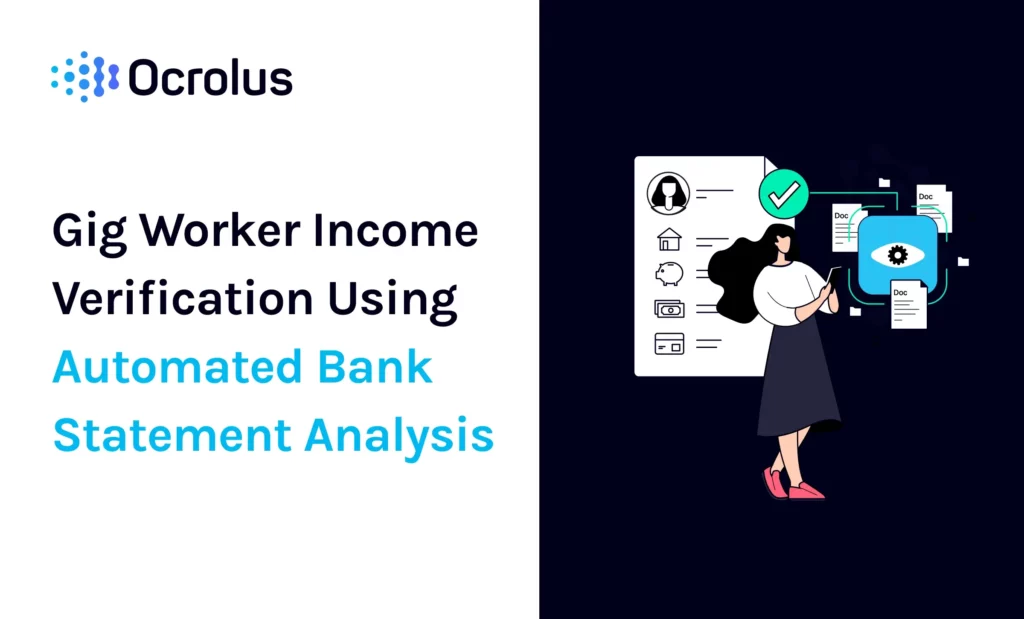This website uses cookies so that we can provide you with the best user experience possible. Cookie information is stored in your browser and performs functions such as recognising you when you return to our website and helping our team to understand which sections of the website you find most interesting and useful.
Gig Worker Income Verification Using Automated Bank Statement Analysis

More than one third (about 36%) of U.S. workers take part in the gig economy, or the rapidly growing job market consisting of temporary, part-time, and freelance work. Some gig workers only dabble a few hours a week for pocket money, while others invest themselves full-time in freelance work. While ride sharing apps and online marketplaces are always in the news, the fastest-growing segments of the gig economy are actually in knowledge-intensive industries, according to a report by McKinsey. Combine these higher earning gig workers with payroll-based employees increasing their income with “side hustles,” and you have a growing market segment that falls outside traditional models for documenting income and determining mortgage eligibility.
Gig workers and freelancers also rely on deductions to reduce their yearly tax liability. They deduct the costs of tools, supplies, vehicles, and – the big one – their home offices. Naturally, this shrinks the adjusted income of gig workers. Since Fannie and Freddie Mae standards require underwriters to rely on payroll documentation and tax documents for verification of income, qualifying for mortgages is often harder for gig workers.
Non-qualified mortgage (non-QM) loans are an attractive alternative for these borrowers, offering a number of advantages including:
- Higher debt to income ratios
- Flexibility in underwriting guidelines
- Alternative income verification options
- Financing made simple for self-employed borrowers
- Financing available for recent credit event borrowers
- ITIN borrowers (foreign nationals) accommodated
While GSEs require tax forms, many lenders offering non-QM loans use borrower bank statements to verify income. By applying cash flow analysis to bank statements, non-QM lenders can measure a borrower’s real income using actual bank account data, instead of secondary documents. However, most non-QM lenders still manually review bank statements to calculate and verify income for gig workers.
Manual bank statement analysis is slow, expensive, and prone to human error. This leads to fewer applications analyzed, more bad debt, less scalability, and more friction in the customer experience. To eliminate these inefficiencies, some lenders have turned to technology such as automated bank statement analysis. With this technology, loan underwriters can eliminate manual document review altogether.
___________________________________________________________
“The gig economy is making it harder for borrowers to document what they do. At the same time, we have multigenerational households that have pooled their resources in order to make ends meet. All of these things are causing us to think how we underwrite those borrowers, how we document their incomes, and how we think about the risks they represent.”
____________________________________________________________
Automated bank statement analysis replaces tedious manual underwriting with a faster, more accurate, and scalable technology. Here’s an example of how it works: PDF bank statements are uploaded directly by borrowers, data from the bank statements is extracted and validated, and analytics such as borrower income are calculated. The data and analytics are then inputted directly into a lender’s loan origination system for decision making. This combines all the core stages of bank statement review – data extraction, data validation, and document analysis – into a single technology platform.
To produce competitive efficiencies, the best solutions for automated bank statement analysis apply advanced technology such as machine learning. Consider some examples:
- Computer vision identifying, parsing, and reading bank statements with a high degree of accuracy
- AI-based document fraud detection identifying potentially fraudulent or doctored bank statements
- Machine learning feedback loops teaching systems to recognize similar data in subsequent documents.
The most effective solutions include some layer of human review, designed to validate data points that are too difficult for the machine to read. Once validated by humans, the correct data is then fed back into the system to constantly improve data accuracy and speed of analysis.
Compared to manual review, automated bank statement analysis enables mortgage lenders to review and fund more deals, while incurring less risk. The technology eliminates manual analysis and calculates borrower income. For non-QM loan programs, this is the kind of technology that opens up the funnel to more applicants from the gig economy, allowing lenders to scale more rapidly without having to hire more data entry resources.
As the percentage of Americans in the gig economy is expected to reach 43% by 2020, mortgage lenders that are best equipped to convert this cohort will reap the rewards. By automating bank statement analysis, lenders can quickly and accurately verify income for gig workers and lay the groundwork for the coming boom in non-QM mortgages.
# # #
Tim Dubes is Vice President of Marketing with Ocrolus, a fintech infrastructure company that transforms documents into actionable data with over 99% accuracy.
Learn more about digital transformation in mortgage and our mortgage automation software today.”
Download “Investor Insights: The Mortgage Firehose, A Catalyst for Fintech“.





